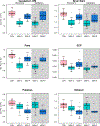Imaging biomarkers for early multiple system atrophy
- PMID: 36063706
- PMCID: PMC10597684
- DOI: 10.1016/j.parkreldis.2022.08.028
Imaging biomarkers for early multiple system atrophy
Abstract
Objective: To systematically evaluate structural MRI and diffusion MRI features for cross-sectional discrimination and tracking of longitudinal disease progression in early multiple system atrophy (MSA).
Methods: In a prospective, longitudinal study of synucleinopathies with imaging on 14 controls and 29 MSA patients recruited at an early disease stage (15 predominant cerebellar ataxia subtype or MSA-C and 14 predominant parkinsonism subtype or MSA-P), we computed regional morphometric and diffusion MRI features. We identified morphometric features by ranking them based on their ability to distinguish MSA-C from controls and MSA-P from controls and evaluated diffusion changes in these regions. For the top performing regions, we evaluated their utility for tracking longitudinal disease progression using imaging from 12-month follow-up and computed sample size estimates for a hypothetical clinical trial in MSA. We also computed these selected morphometric features in an independent validation dataset.
Results: We found that morphometric changes in the cerebellar white matter, brainstem, and pons can separate early MSA-C patients from controls both cross-sectionally and longitudinally (p < 0.01). The putamen and striatum, though useful for separating early MSA-P patients from control subjects at baseline, were not useful for tracking MSA disease progression. Cerebellum white matter diffusion changes aided in capturing early disease related degeneration in MSA.
Interpretation: Regardless of clinically predominant features at the time of MSA assessment, brainstem and cerebellar pathways progressively deteriorate with disease progression. Quantitative measurements of these regions are promising biomarkers for MSA diagnosis in early disease stage and potential surrogate markers for future MSA clinical trials.
Keywords: Imaging biomarkers; MRI; Multiple system atrophy.
Copyright © 2022 Elsevier Ltd. All rights reserved.
Conflict of interest statement
Declaration of competing interest There are no disclosures relevant to this manuscript.
Figures




References
Publication types
MeSH terms
Substances
Grants and funding
LinkOut - more resources
Full Text Sources

